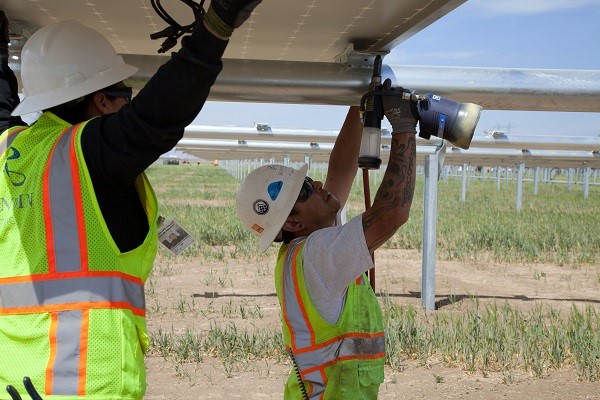Center for American Progress
Mainstream media coverage of climate change presents the manufacturing sector of the economy as one of the fiercest enemies of climate action in the United States. But this sector, which is also usually painted as one of the biggest sources of carbon pollution in the country, is actually vital to the process of building a low-carbon economy. Remaking old systems such as the electricity grid will require new clean energy products, and the development of new sectors will be fueled by technological innovation. For advanced economies such as the United States, it’s increasingly clear that manufacturing and innovation go hand in hand, and emerging sectors, including renewable energy, restoration and resilience, and low-carbon transportation, will depend on a strong and vibrant domestic manufacturing sector.
By innovating, engineering, and manufacturing clean energy technologies, the United States can create good jobs for the middle class and fight climate change—all while securing a share in the booming global clean energy market.
The U.S. Department of Energy’s new Clean Energy Manufacturing Initiative is a nod to this crucial connection between America’s manufacturing sector and our low-carbon future. The program aims to build on America’s strength as a bottom-up innovator by focusing on different manufacturing strategies and economic-development opportunities in different regions of the country.
The program is a great start, but it’s not enough. Robust policies—the kind only Congress can champion—are needed to support a domestic clean energy manufacturing industry. As a starting point for such a policy, we argue that:
- Congress should authorize $2 billion in funding for the National Network for Manufacturing Innovation and should focus several of the program’s Institutes for Manufacturing Innovation on clean energy projects
- Congress should reauthorize the successful advanced manufacturing tax credit, which provides a 30 percent investment tax credit in manufacturing facilities for clean energy products, for a 5-year to 10-year period with a clear sunset path and totaling $5 billion in new funding
- Congress should enact a progressive carbon tax that generates demand for clean energy products while fighting climate change
These policies will create jobs through encouraging investment in the manufacturing industry, boost competitiveness by providing clean energy goods to a global market, and reduce greenhouse gases in the atmosphere by fostering clean technological alternatives.
Clean energy manufacturing is good for the economy and the climate
Throughout our country’s history, a strong manufacturing industry has helped propel the United States to the cutting edge of global competitiveness. Recent years, however, have seen a dramatic decline in domestic manufacturing. Policies that currently bolster the domestic production of clean energy goods can help renew the manufacturing industry while creating well-paying jobs and fostering a low-carbon economy that is “made in America.” Because domestic and international demand for clean energy goods is rising at such a rapid rate, focusing on clean energy manufacturing instead of doubling down on the industries of yesterday will give the United States an advantage in a growing market.
 The Antelope Valley Solar Projects being built in California are among MidAmerican’s holdings (image via SunPower)
The Antelope Valley Solar Projects being built in California are among MidAmerican’s holdings (image via SunPower)
The strong economic case for manufacturing
There is no doubt that the manufacturing sector was hit hard during the recent recession, with 2 million jobs lost in the 18-month period between December 2007 and June 2009. The big picture, however, shows that the recession merely accelerated a decline in manufacturing employment and output that has been occurring since just after 2000—and, some would argue, since its peak in 1978.
Recently, however, there has been an uptick in domestic manufacturing that has inspired discussion of a possible manufacturing renaissance in the United States. Factors driving this discussion have included increasing U.S. labor productivity, rising wages in other countries—particularly China—and the strengthening business case for having design, management, and production facilities in close proximity to one another. The trend toward just-in-time production—which encourages replenishing materials and supplies as they are needed—and custom-made goods has also increased the importance of geographic proximity between manufacturers and their final customers.
These are all compelling reasons to promote U.S. manufacturing, but so is the simple fact that increasing U.S. manufacturing output would strengthen the overall economy. Manufacturing generated 12.2 percent of total gross domestic product in 2011, and every $1 spent on manufacturing creates $1.35 in additional economic activity. The sector as a whole is significant in that it has a very high multiplier effect, meaning that every job created in manufacturing generates several more jobs in other sectors. Each job in motor-vehicle manufacturing, for example, creates 8.6 indirect jobs; each job in computer manufacturing creates 5.6 indirect jobs; and each job in steel-product manufacturing creates 10.3 indirect jobs.
A revitalized manufacturing sector would also have a positive effect on exports, lowering our trade deficit with other countries by boosting the amount of products other countries purchase and providing homemade goods for domestic consumption instead of imports.
Clean energy would benefit from domestic manufacturing
Just because manufacturing is generally economically positive for the United States, however, does not mean we should promote a domestic manufacturing strategy in all sectors of the economy. The garment industry (aside from niche products) is the classic example of an industry that has irretrievably gone to lower-cost countries; some argue that traditional photovoltaic solar panels might be in this category as well. The question, then, becomes this: If our goal is a low-carbon economy, what kind of manufacturing should we support to achieve that goal?
The obvious answer is the manufacturing of clean energy technologies that are either innovative or that have a strong U.S. market, or both. And there are certainly some clean energy sectors that fit this bill—for example, the renewable-energy industry. The American Recovery and Reinvestment Act, passed in 2009, put an unprecedented amount of federal support behind renewable-energy technologies through various production and manufacturing tax credits and created a huge new market for these technologies. The result of these investments was a $1.63 billion trade surplus with China in renewable-energy goods and services in 2011—the same year that our overall trade deficit with China was $301.6 billion, which resulted in 2.7 million job losses between 2001 and 2011, 76 percent of which were in the manufacturing sector alone.
While the Recovery Act, combined with complimentary state policies, helped create huge demand for clean energy products here at home, which drove the manufacturing boom, it is clear that our domestic production can easily find foreign markets as well—there is certainly no shortage of buyers for clean energy products globally. Clean energy investments in 2012 topped $269 billion, a decline from 2011 levels but a massive market nonetheless. Investments in China alone represented $65.1 billion of this market in 2012, with the United States attracting $35.6 billion. Put another way, the market for clean energy goods and services in China is booming, and more domestic manufacturing would place the United States in a position to capitalize on the trend of being a net exporter of renewable-energy products.
Increasing clean energy manufacturing would also create new jobs in America. As of 2011, half a million manufacturing jobs were classified as green jobs. Another report finds that jobs in the clean economy are particularly manufacturing intensive, with about 26 percent of all clean-economy jobs being in manufacturing. These tend to be high-quality jobs with median wages 13 percent higher than the U.S. median. With unemployment in manufacturing still hovering around 6.4 percent, American workers stand to gain from a focus on clean energy manufacturing.
Economic growth and combating climate change can go hand in hand
Gone are the days that we can base an argument for the low-carbon future on jobs and economic-growth potential alone. Climate change has crept up in this country as the single-most important issue facing our economy and way of life because of its tremendously destructive potential and the transformative implications it has for businesses and government. With 14 extreme weather events in 2011 that caused more than $1 billion in damages each, the economic toll of climate change is mounting and promises to only get worse as time goes on. Definitive adaptation and mitigation efforts must begin immediately if the United States is to have any hope of blunting the blow these disasters stand to deliver.
The transition to a low-carbon economy will be a step in the right direction toward fighting climate change while creating new businesses and jobs. Far from being opposing forces, economic growth and mitigation and adaptation efforts are firmly intertwined. A low-carbon economy requires new goods and services, and clean energy and efficiency technology significantly outperforms its dirtier counterparts in terms of jobs generated per $1 million invested.
There are also economic benefits in making the United States more resilient to the immediate impacts of climate change even as we fight the future impacts. By taking a holistic approach to this economic transition—including using construction materials such as permeable pavement, building smart storm-water management, and deploying a smarter electrical grid—cities and states can lower their overall operating costs and help fill the massive gap in projected infrastructure spending.
Clean energy manufacturing must be a core part of any strategy to create a low-carbon economy. By orienting U.S. manufacturing firms and workers to supply the products needed for this clean energy transition, the United States can ensure that high percentages of high-quality domestic content go into building new, sustainable markets and infrastructure.
More at EarthTechling



